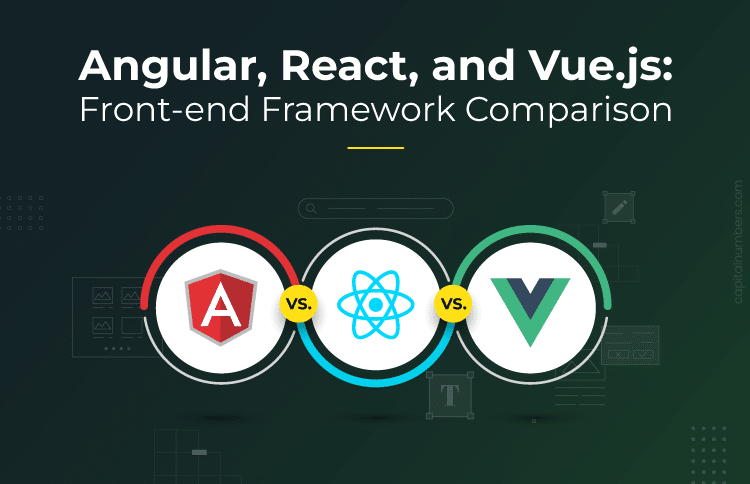Angular vs. React vs. Vue.js: Which is the Best Front-End Framework for Your Web App?
Table of Contents
Did you know that the choice of front-end framework can significantly impact the success of your web application? The right framework can improve development speed, user experience, and scalability.
This blog aims to help tech leads and project managers understand the differences between Angular, React, and Vue.js. By comparing these three popular front-end frameworks, we will provide insights into their strengths and weaknesses, helping you make an informed decision for your next web app project. Additionally, for those considering hiring front-end developers, this guide will assist in selecting the best framework to match your team’s expertise and project needs.
Overview of Each Framework
Angular:
- History and Background: Angular was developed by Google and first released in 2010 as AngularJS. It was a revolutionary framework for building dynamic web applications. In 2016, Google released a complete rewrite of AngularJS called Angular (or Angular 2+). Since then, Angular has continued to evolve with regular updates and improvements.
- Core Features:
- Two-Way Data Binding: This feature allows automatic synchronization of data between the model and the view, making it easier to manage complex data-driven applications.
- Dependency Injection: This design pattern improves code maintainability and testing by managing how components are created and shared.
- TypeScript Integration: Angular is built with TypeScript, a statically typed superset of JavaScript, which helps catch errors early during development and improves code quality.
- Use Cases: Angular is best suited for large-scale enterprise applications that require robust structure and maintainability. It is ideal for projects with complex requirements and long-term support needs.
React:
- History and Background: React was developed by Facebook and first released in 2013. It was created to address the need for a more efficient way to build user interfaces, particularly for applications that require frequent updates and dynamic content.
- Core Features:
- Virtual DOM: React uses a virtual representation of the DOM to optimize updates and rendering. This results in faster performance and a smoother user experience.
- Component-Based Architecture: React allows developers to build reusable UI components, which can be combined to create complex interfaces.
- JSX: JSX is a syntax extension for JavaScript that allows developers to write HTML-like code within JavaScript. This makes the code more readable and easier to debug.
- Use Cases: React is ideal for single-page applications (SPAs) and dynamic user interfaces where performance and scalability are crucial. It is widely used for building interactive and high-performing web applications.
Vue.js:
- History and Background: Vue.js was created by Evan You and first released in 2014. It was designed to be an approachable, versatile, and performant framework for building user interfaces. Vue.js has gained popularity due to its simplicity and ease of integration.
- Core Features:
- Reactive Data Binding: Vue.js provides a reactive data binding system that automatically updates the view when the data changes, making it easy to manage state.
- Simple API: Vue.js has a straightforward and flexible API, which makes it easy to learn and use.
- Component-Based Architecture: Similar to React, Vue.js uses a component-based approach, allowing developers to build reusable and modular UI components.
- Use Cases: Vue.js is great for small to medium-sized applications and progressive enhancements. It is particularly suitable for projects that require quick development and easy integration with existing projects.
Comparison Criteria
When choosing a front-end framework, it’s essential to consider several key factors. Here, we compare Angular, React, and Vue.js based on performance, development experience, scalability, and flexibility.
Performance:
- Rendering Speed:
- Angular: Angular uses a real DOM and change detection strategy which can be slower compared to React and Vue.js for very dynamic interfaces.
- React: React uses a virtual DOM, which makes it very efficient in updating and rendering components, leading to fast performance.
- Vue.js: Vue.js also uses a virtual DOM, providing fast and efficient updates, similar to React.
- Load Time:
- Angular: Angular applications can have longer initial load times due to the size of the framework, but it includes Ahead-of-Time (AOT) compilation to reduce load times.
- React: React is lightweight, and its applications generally load quickly. However, the load time can vary depending on the size of the application and included libraries.
- Vue.js: Vue.js is lightweight and designed for fast initial load times. Its simplicity helps in keeping the bundle size small.
Development Experience:
- Learning Curve:
- Angular: Angular has a steep learning curve due to its comprehensive and complex nature. It requires learning TypeScript and various Angular-specific concepts.
- React: React has a moderate learning curve. React developers need to learn JSX and understand the component-based architecture but can start building projects relatively quickly.
- Vue.js: Vue.js has the gentlest learning curve. It’s straightforward and easy to understand, making it accessible for beginners.
- Tooling and Ecosystem:
- Angular: Angular has a robust CLI (Command Line Interface) and a comprehensive set of tools built into the framework. It has a strong ecosystem with extensive libraries and official support for many common tasks.
- React: React has a vast ecosystem with many third-party tools and libraries. While it doesn’t have as extensive an official toolset as Angular, it offers a lot of flexibility and a wide range of community-driven tools.
- Vue.js: Vue.js has a CLI and a good selection of tools and libraries, though it may not be as extensive as React or Angular. Its ecosystem is growing rapidly, with strong community support.
- Documentation and Community Support:
- Angular: Angular has comprehensive documentation and a large community, providing plenty of resources for learning and troubleshooting.
- React: React’s documentation is thorough, and it has one of the largest developer communities, making it easy to find tutorials, libraries, and community support.
- Vue.js: Vue.js is known for its excellent documentation and has a supportive and growing community. It is easy to find resources and help.
Scalability:
- Modularity:
- Angular: Angular is highly modular and supports large-scale projects well. It encourages the use of modules, which makes it easier to manage large codebases.
- React: React is also modular with its component-based architecture. It can handle large projects effectively, but developers need to be mindful of organizing their code.
- Vue.js: Vue.js supports modularity through its component system. It is suitable for both small and large projects, but its simplicity makes it particularly effective for small to medium-sized projects.
- Maintainability:
- Angular: The strong structure and conventions make it easier for Angular developers to maintain and update large applications.
- React: React’s component-based architecture helps with maintainability, but it relies on the developer to organize and manage the code effectively.
- Vue.js: Vue.js is easy to maintain due to its simplicity and clear structure, making it a good choice for projects that require ongoing updates and improvements.
Flexibility and Customization:
- Flexibility in Design:
- Angular: Angular is less flexible due to its opinionated nature. It provides a lot of built-in functionality but can be restrictive in how you build certain features.
- React: React is highly flexible, allowing developers to choose and integrate various libraries and tools to suit their needs.
- Vue.js: Vue.js offers a balance between built-in features and flexibility, allowing developers to use it in a way that fits their specific needs.
- Third-Party Integrations:
- Angular: Angular has extensive official and third-party libraries for a wide range of functionalities, making integrations straightforward.
- React: React’s vast ecosystem includes numerous third-party libraries, offering a wide range of integration options.
- Vue.js: Vue.js has many third-party integrations and a growing number of official libraries, making it easy to extend its functionality.
Comparison Table
| Criteria | Angular | React | Vue.js |
|---|---|---|---|
| Rendering Speed | Fast with AOT compilation | Fast with Virtual DOM | Fast with reactive data binding |
| Learning Curve | Steep | Moderate | Gentle |
| Tooling | CLI, Integrated tools | Rich ecosystem, many third-party tools | CLI, integrated tools |
| Community Support | Large, backed by Google | Very large, backed by Facebook | Growing, strong support community |
| Modularity | Strong modular system | High flexibility with component-based | High flexibility with component-based |
| Documentation | Comprehensive | Comprehensive | Excellent |
| Third-Party Integrations | Extensive official and third-party libraries | Extensive third-party libraries | Many third-party libraries |
| Best For | Large-scale, enterprise-level applications | Dynamic SPAs, interactive UIs | Small to medium-sized applications |
Pros and Cons of Each Framework
Angular:
- Pros:
- Comprehensive Solution: Angular provides a complete framework with everything you need to build a web application, from templates to tools and testing.
- Strong Community: Angular has a large and active community, backed by Google, which means plenty of resources, support, and regular updates.
- Great for Large Projects: Angular’s structure and features make it well-suited for large-scale enterprise applications that need a robust and maintainable architecture.
- Cons:
- Steep Learning Curve: Angular can be challenging to learn due to its complexity and the requirement to understand concepts like TypeScript and dependency injection.
- Heavier Compared to Others: Angular applications can be larger in size, which might affect initial load times and performance if not optimized properly.
React:
- Pros:
- High Performance: React’s use of the virtual DOM results in fast and efficient updates, providing a smooth user experience.
- Vast Ecosystem: React has a rich ecosystem with numerous libraries and tools available to extend its functionality, offering great flexibility.
- Strong Community Support: React has a massive community and is maintained by Facebook, ensuring plenty of resources, frequent updates, and a wide range of third-party integrations.
- Cons:
- Can Be Overwhelming: The flexibility of React means there are many ways to achieve the same goal, which can be confusing and overwhelming for developers, especially beginners.
- Relies on Third-Party Libraries: React provides the core library for building user interfaces, but you often need additional third-party libraries for routing, state management, and other functionalities, which can lead to inconsistencies.
Vue.js:
- Pros:
- Easy to Learn: Vue.js is known for its gentle learning curve and straightforward syntax, making it accessible for beginners and experienced developers alike.
- Flexible: Vue.js offers a lot of flexibility, allowing developers to structure their projects in a way that suits their needs, whether for small or large applications.
- Great Documentation: Vue.js has excellent and clear documentation, which helps developers understand and use the framework effectively.
- Cons:
- Smaller Community: Vue.js has a smaller community compared to React and Angular, which means fewer resources and third-party libraries.
- Less Corporate Backing: Unlike Angular and React, which are backed by Google and Facebook respectively, Vue.js does not have strong corporate backing. This can sometimes lead to concerns about long-term support and development.
Case Studies and Industry Examples
Angular:
Angular is often chosen by large enterprises for its robust structure and scalability. Here are a few examples:
- Google: Since Angular is developed by Google, many of their applications use it. For example, Google Cloud Console is built with Angular, showcasing its ability to handle complex and large-scale applications.
- Microsoft Office Online: Microsoft uses Angular for their online Office suite, demonstrating its capability in creating feature-rich, enterprise-level applications.
- Gmail: Angular’s ability to manage large, dynamic content efficiently makes it suitable for applications like Gmail, where performance and user experience are crucial.
React:
React is widely used for building interactive and dynamic user interfaces. Here are some examples:
- Facebook: As the creator of React, Facebook uses it extensively in their platform. React powers both the Facebook website and their mobile app, highlighting its flexibility and performance.
- Instagram: Another popular platform owned by Facebook, Instagram uses React to ensure a smooth and dynamic user experience.
- Airbnb: Airbnb leverages React to create a seamless and responsive user interface, enhancing user interaction and performance across their platform.
Vue.js:
Vue.js is known for its simplicity and ease of integration. Here are some examples:
- Alibaba: The e-commerce giant Alibaba uses Vue.js for some of its applications, showcasing its capability to handle large-scale traffic and complex user interfaces.
- Grammarly: The popular writing assistant tool, Grammarly, uses Vue.js to create an intuitive and responsive user interface for their browser extensions.
- Xiaomi: Xiaomi, the electronics company, employs Vue.js in several of their applications, demonstrating its versatility and performance in diverse use cases.
Decision-Making Guide
Choosing the right front-end framework involves careful consideration of several factors. Here’s a guide to help tech leads and project managers make an informed decision:
Project Requirements:
- Assessing Project Size: Determine whether your project is small, medium, or large. Large-scale projects with complex requirements may benefit from the comprehensive features of Angular. Smaller projects might find Vue.js more suitable due to its simplicity and quick setup.
- Complexity: Consider how complex your application will be. For highly dynamic and interactive applications, React’s flexibility and performance may be advantageous. For projects that need robust structure and advanced features out-of-the-box, Angular might be a better choice.
- Specific Needs: Identify the specific needs of your project. If you need two-way data binding and a full-featured framework, Angular is ideal. If you prefer a lightweight solution with a gentle learning curve, Vue.js might be the best fit. React is great if you need a highly flexible and component-based approach.
Team Expertise:
- Skillset and Experience: Evaluate the skills and experience of your development team. If your team is already proficient in TypeScript, Angular could be a natural fit. For teams familiar with JavaScript and looking for flexibility, React is an excellent choice. Vue.js is great for teams that need an easy-to-learn framework or are new to front-end development.
- Learning Curve: Consider the learning curve associated with each framework. Angular has a steep learning curve but offers a lot of built-in functionality. React has a moderate learning curve and is widely used, making it easier to find resources and support. Vue.js has the easiest learning curve, making it accessible for beginners and quick to implement.
Long-Term Goals:
- Maintenance: Think about how easy it will be to maintain and update your application over time. Angular’s strong structure can make maintenance easier for large projects. React’s component-based architecture also supports maintainability but requires good organization practices. Vue.js is straightforward to maintain due to its simplicity and clear structure.
- Scalability: Consider your future plans for the application. If you anticipate significant growth and need a framework that can scale with your project, Angular’s modularity and comprehensive nature are beneficial. React also scales well due to its flexibility and vast ecosystem. Vue.js can handle growth effectively, especially for small to medium-sized projects, but might require additional planning for very large applications.
Conclusion
In this blog, we explored the features and benefits of Angular, React, and Vue.js. We discussed their performance, development experience, scalability, and flexibility. We also looked at real-world examples and provided a decision-making guide based on project requirements, team expertise, and long-term goals. When it comes to web application development, choosing the right framework is crucial. Select the one that best matches your project needs and team skills.
Ready to take your web application to the next level? Hire our skilled front-end developers who specialize in Angular, React, and Vue.js. Let us help you build engaging, high-performance applications tailored to your needs. Contact us today to discuss your project and see how our expertise can drive your success!















